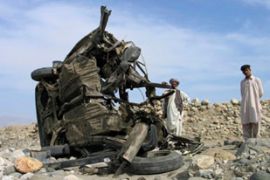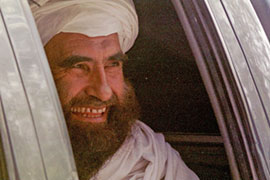Losing the east in Afghanistan
Wikileak documents underline slow deterioration of security in eastern provinces.

Deteriorating situation
The east of Afghanistan shows up little in reports from 2004 and 2005, with documents from 2006 focusing to a large extent on development.
In April 2006, Nato opened a girls’ school in Paktia province; in October 2006, the province got a new rural health clinic.
Reconstruction teams worked on a new bridge in Nuristan province in May 2006.
In January 2007, US troops talked with the governor of Paktika about improving access to education.
He encouraged them to focus on development projects, and stressed that “security will follow development” in the province, the report said.
By mid-2007, though, the reports began to take a more ominous tone. Two doctors were kidnapped in Nuristan in June 2007.
A suicide bomber attacked the police headquarters in Logar province in October 2007.
Fighters began staging regular rocket attacks against Nato soldiers, with at least a half-dozen mentions of such incidents in summer and autumn of 2007.
The escalating violence made Nato soldiers and civilians jumpy.
A provincial reconstruction team (PRT) shot and killed a civilian in October 2007 in Gardez, the capital of Paktika province, because he was wearing a “bulky jacket”.
“The overall security of Paktia appears to be decreasing,” was the conclusion of an October 2007 report, a conclusion mirrored by several other reports from nearby provinces.
Haqqani rising in the east
The leaked reports also chart the ascent of the Haqqani network, whose rise brought about much of the insecurity in the east.
 |
| The Haqqani network is named after Jalaluddin Haqqani, its leader [GALLO/GETTY]) |
Haqqani was scarcely mentioned during the early years of the war.
There is a report of a “night letter” in January 2004, for example, calling for attacks against US troops in Khost province.
“[Taliban] official Muhammad Khan Gorbaz wrote it in co-operation with Sirajuddin Haqqani [the son of Jalaluddin Haqqani, the leader of Haqqani] and Maulawi Naebsalar,” the report said.
It then went on to explain who Sirajuddin was, a footnote that seems almost absurd six years later, with Sirajuddin at the head of Afghanistan’s deadliest insurgent group.
The Haqqani network surfaces in a few other reports – an attack on a government office in Zabul in June 2004, an ambush in Gardez in April 2005 – but remains a minor concern until the summer of 2006.
Then it quickly became a major concern for Nato.
Haqqani fighters ambushed two supply trucks in August 2006; two months later, they rocketed a provincial reconstruction team in Paktika province; just weeks later, Nato warned of Haqqani suicide bombers plotting an attack in Kabul.
‘Power and prestige’
Afghan intelligence officials began warning that former members of the Taliban who had made reconciliation deals with the government were being lured back to the insurgency.
“[They] were unable to achieve the personal and political power they held under the Taliban,” said Mohammad Nawab, an interior ministry official, in a December 2006 meeting with Nato commanders.
“They said that the former commanders were easily tempted by [Gulbuddin] Hekmatyar [the founder of Hezb-i-Islami, a Taliban group] and Haqqani, who offered money, power and prestige.”
Haqqani’s group continued to plan and stage high-profile attacks against soldiers, PRTs and Afghan civilians throughout 2007 and 2008.
In May 2007, for example, one report noted that the group plotted to use stolen Afghan army vehicles as car bombs.
The security situation has only worsened since then.
There were 147 attacks in Khost province in the first quarter of 2010, up from just 41 in the same period in 2007.
Violence in other provinces increased exponentially as well: Kunar, from 66 attacks to 312; Nangarhar, from 38 to 76.
Ghazni, which had just 4 insurgent attacks in the first quarter of 2007, had 71 in 2010.